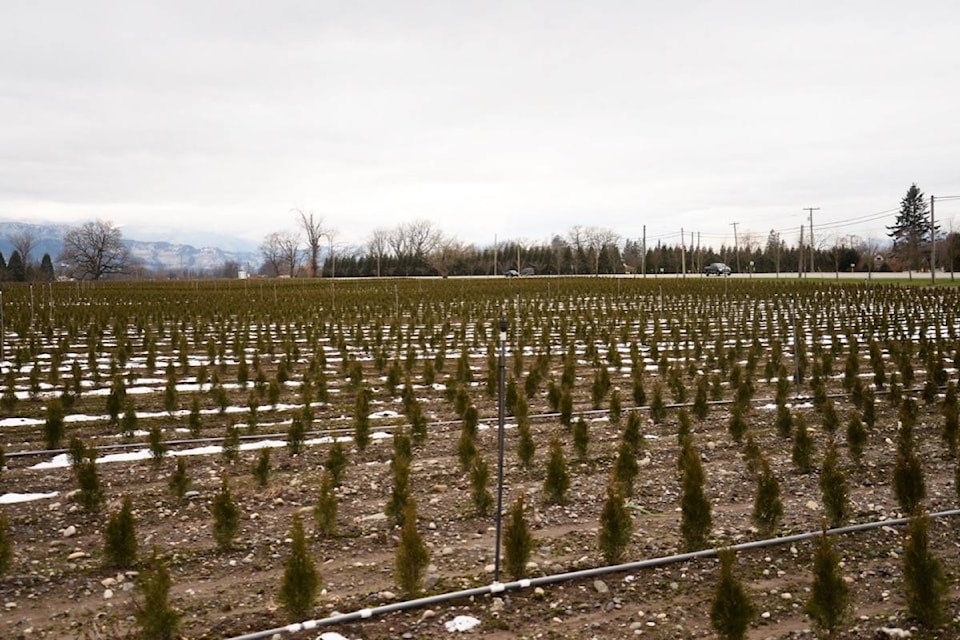A lingering land issue has once again divided District of Kent officials.
By a tied vote of 5-5 after more than an hour of deliberation, the Kent Agriculture Advisory Committee (KAAC) declined to support the District of Kent’s intention to remove the Teacup properties from the Agriculture Land Reserve (ALR) during their Thursday morning meeting. Approximately 10 members of the community attended the meeting in addition to nine committee members.
The initial proposal prior to the question of support was to gather more information prior to making a decision. However, given that the public consultation meeting is only two weeks away, time to gather information is fairly limited. This decision, too, was defeated by a tied 5-5 vote.
The land in question has long been a source of controversy, raw emotion and divide between urban development advocates and the agriculture community in the area.
RELATED: New community plan taking shape in Agassiz
The Teacup properties fall under Class 1, 2 and other high grades of farmland, which makes it extremely valuable for sustainable food growth, which the KAAC sees as especially critical given the relative recent elemental instability brought on by climate change.
Liaison for the Ministry of Agriculture Kim Sutherland, who was present at the meeting, said similar development approaches made life difficult for Mission farmers.
“Now the District of Mission does not have contiguous ALR land and a vibrant agricultural community because it basically has embraced single-housing,” she told the KAAC. “They were considered not as good of farmland as what we’ve got here. It has basically nothing left.”
She criticized the Fraser Valley Regional District (FVRD) for what she believes is a lack of support for agricultural planning.
“[The FVRD] do some good things in terms of climate action,” Sutherland added. “Their plan for climate action is really good, but their planning for agriculture work is bad for the most part.”
From the district’s development perspective, there is a figurative and literal uphill battle in developing housing elsewhere outside of the Teacup properties and other ALR land.
“As a community that is proud to have a small-town farming identity, we have struggled to accept that to accommodate growth in a sustainable way, there may have to be some concessions to balance our community’s needs over time,” said District Mayor Sylvia Pranger in a video statement. “This exclusion proposal, if reviewed in its entirety, gives the District of Kent an opportunity to preserve agricultural land within our community…while welcoming people to enjoy a small-town farming lifestyle we have worked very hard to maintain.”
Committee Member Tom Baldwin said he had great respect for the ALR yet also recognized the increasing housing pressure that crept ever eastward from Vancouver and has hit Agassiz. Baldwin casted his vote to support the District’s application.
The district presented the KAAC with a 25-minute video running down the history of the Teacup properties stretching back 25 years.
Back in 1994, the 11.3-hectare Twilhaar property (also known as part of the Teacup properties) was designated in the District’s Official Community Plan (OCP) as residential and it was excluded from the ALR. Five years later, the FVRD performed a population density analysis to aid in future population growth, which found that the District of Kent was the highest in population density, which was attributed to the tight boundaries of the surrounding agricultural land.
In the 2001 OCP update, the district designated the Teacup properties as residential reserve land. This designation was to pave the way for future residential expansion as eastward population migration continued. Between 2001 and 2003, the Agriculture Land Commission (ALC) approved land expansions around the Agassiz town site – a 2.2.-hectare property for a senior centre and a 1.4-hectare property for single-family homes.
RELATED: ALC decision protects Agassiz farmland
In 2005, the district council unanimously defeated the Gateway Neighbourhood Plan, which would have removed the Teacup properties from the ALR; district officials during that term did not feel the timing was right to release the lands for residential development.
In subsequent years, further development of existing residential land as well as that of Mount Woodside relieved growth pressure. In 2014, the OCP underwent another update. The ALC agreed with the updated OCP that Kent did need to find more land for housing but was it was not in favour of Teacup property removal. The land was still designated as reserve residential at that time.
Two years later, an unnamed applicant applied to exclude 14.4 hectares of Teacup land for residential and limited commercial development over the course of the next few decades. The applicant wished to include 40.8 hectares of land into the ALR and a $2 million contribution for district improvements and agricultural research was also proposed. The applicant also wished to donate topsoil from the Teacup properties for agriculture use.
Throughout 2017, the applicant and district officials asked for continued feedback from the community. In February of that year, the council expressed their support of the proposal. Ten months later, the ALC refused the proposed exclusion and did so again in October of 2018.
The most recent proposal is asking for 17.26 hectares with 40.8 hectares returned to the ALR and a $3 million contribution and donated topsoil. It’s not clear whether or not the gained 23.54 hectares is of the same or similar grade of prime farmland as the Teacup properties.
See full coverage at www.agassizharrisonobserver.com.
A public consultation meeting in which the public may participate is scheduled for Tuesday, March 10, from 7 p.m. to 9 p.m. at the Friendship House, 7272 Morrow Road.
